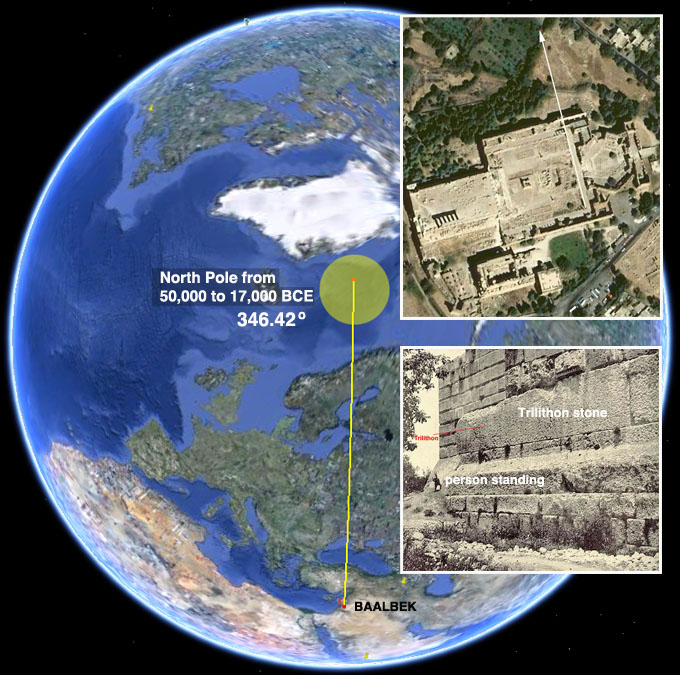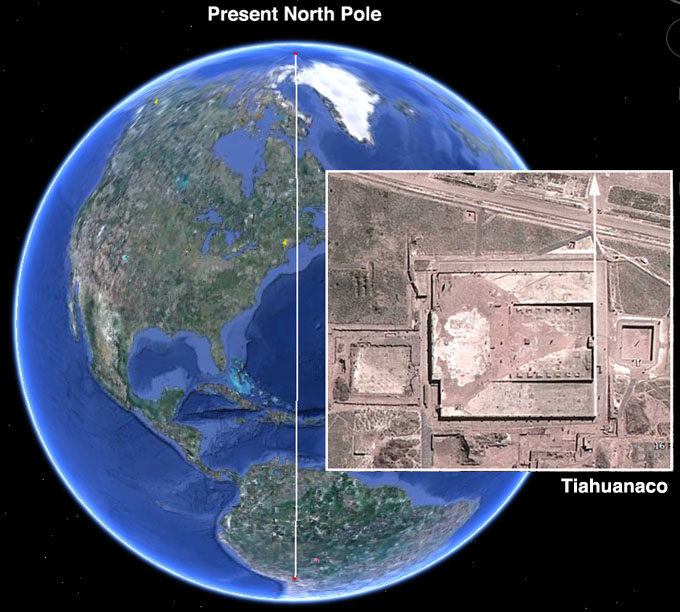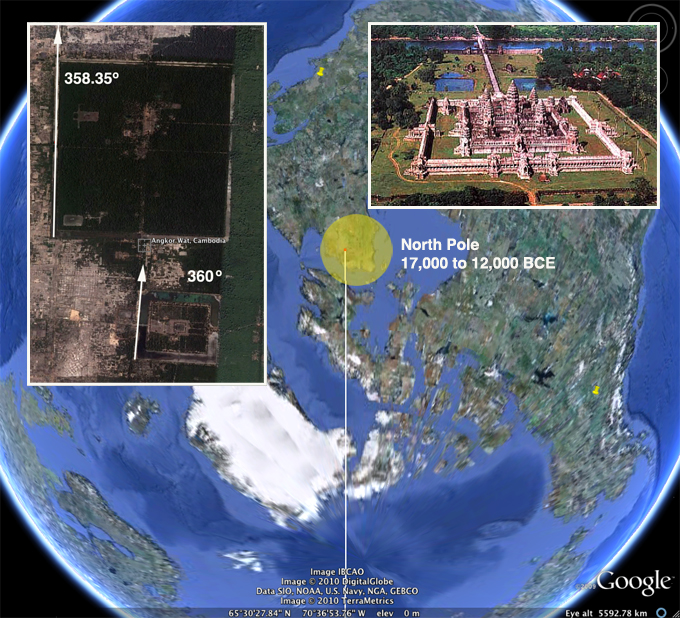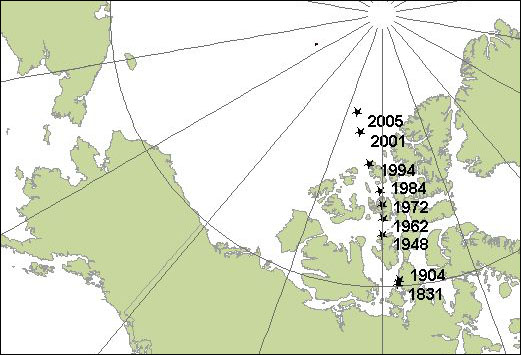Baalbek
The history settlement in the area of Baalbek dates back approximately 9000 years, with almost continual settlement of the tell under the Temple of Jupiter. The base of the famous Temple of Jupiter is made of huge stones that weigh as much as 300 tons! How they were carved and moved in to place remains a mystery.
In his books on ancient history, Zecharia Sitchin proposed that the site was much older than 9000 years and suggested it might have been used by extraterrestrials as a base for their space vehicles. We tested his hypothesis by locating the East alignment for the temples foundation and ten extended a line North.

We can see that the North line intersects perfectly with the North Pole as is calculated to be from about 50,000 years ago to about 17,000 BCE. This is the only alignment of the foundation that makes any sense.
Tiahuanaco, Bolivia
Ask most people who are the oldest civilization or where the oldest civilization lived and you'll here answers like Mesopotamia (Iraq), Egypt or Iran. While these cultures can be traced back to 4000 B.C., the mysterious ruins ofTiahuanaco, in Bolivia, are thought to be 14,000 years old!

We tested this theory by aligning the famous Sun Gate and the surrounding temple to face the rising sun -- exactly East. Then we traced the North line at 360 degrees to, where else, the present North Pole. This means that the temple and the Sun Gate were aligned sometime between 12,000 BCE and the present.
Angkor Wat, Cambodia
Angkor Wat (or Angkor Vat) is a temple complex at Angkor, Cambodia, built for the king Suryavarman II in the early 12th century as his state temple and capital city. As the best-preserved temple at the site, it is the only one to have remained a significant religious centre since its foundation -- first Hindu, dedicated to the god Vishnu, then Buddhist. The temple is the epitome of the high classical style of Khmer architecture. It has become a symbol of Cambodia, appearing on its national flag, and it is the country's prime attraction for visitors.
Suryavarman is said to have selected the site based on some extremely ancient artifacts that were found there. So, once again we looked for the orientation of the foundations to see which position of North was used.

Surprisingly, there are two different orientations found at the site. One is dead-on 360 degrees -- obviously the North Pole of today. The other is off by a few degrees (as seen in the photo above) and aligns with the position of the North Pole for the period 17,000 to 12,000 BCE.
There is one other anomaly worth mentioning.
The distance from the North Pole to the Equator is about 6215 miles. This is exactly the distance for Angkor Wat to the second pole position located in Alaska. And if a line of 6215 miles is extended from this second position it intersects with the Nazca Lines in Peru, Easter Island, Persepolis, Petra, Anatom Island, the Great Pyramid, and Mohenjodaro in Pakistan. This means that all of these sacred sites were once on the Equator when the North Pole was in the Second Position (50,000 years ago!). Coincidence?
The Magnetic Poles are moving again!
The North polar axis is different from the magnetic North that a compass points to. This discrepancy is often used to support the Shifting Pole theory because it shows that the core, responsible for creating the magnetic field, is not aligned with the rotational axis of the planet. Over time, the two should be more or less identical.
If we have had crustal shift in the past, we ought to see the magnetic North moving toward the North axis. In fact, this is exactly what we do see.

The magnetic north pole had moved little from the time scientists first located it in 1831. Then in 1904, the pole began shifting northeastward at a steady pace of about 9 miles (15 kilometers) a year.
In 1989 it sped up again, and in 2007 scientists confirmed that the pole is now galloping toward Siberia at 34 to 37 miles (55 to 60 kilometers) a year! Is this fast? To put it in perspective, the last shift from Position #3 (in the Northeast shore of Hudson Bay) to the present Position #4 (the current North Pole) covered just 2000 miles. Traditional scientists like to imagine that this took thousands of years to happen. Remember, Hapgood believed this happened suddenly. At the current rate at which the poles are moving, this same distance would take just 55 years!
Food for thought
Second super-fast flip of Earth's poles found -- reported in www.newscientist.com:
SOME 16 million years ago, north became south in a matter of years. Such fast flips are impossible, according to models of the Earth's core, but this is now the second time that evidence has been found.
The magnetic poles swap every 300,000 years, a process that normally takes up to 5000 years. In 1995 an ancient lava flow with an unusual magnetic pattern was discovered in Oregon. It suggested that the field at the time was moving by 6 degrees a day - at least 10,000 times faster than usual. "Not many people believed it," says Scott Bogue of Occidental College in Los Angeles.
Now Bogue and his colleague Jonathan Glen of the United States Geological Survey in Menlo Park, California, say they have found a second example in Nevada. The lava rock suggests that in one year, Earth's magnetic field shifted by 53 degrees (Geophysical Research Letters, DOI: 10.1029/2010GL044286). At that rate, a full flip would take less than four years, but there could be another interpretation. "It may have been a burst of rapid acceleration that punctuated the steady movement of the field," says Bogue.
Peter Olson of Johns Hopkins University in Baltimore, Maryland, remains sceptical and points out that the effects could have been local rather than global.
Earth is overdue for a reversal, and rapid shifts would cause widespread chaos - for navigation and migratory birds for instance.

No hay comentarios.:
Publicar un comentario